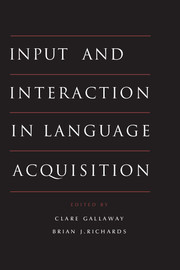Book contents
- Frontmatter
- Contents
- List of figures
- List of tables
- List of contributors
- Preface
- Introduction
- Part I General issues
- Part II Specific aspects of input and interaction
- 5 The rest of the family: the role of fathers and siblings in early language development
- 6 Phonetic and prosodic aspects of Baby Talk
- 7 Language learning at home and school
- Part III Types of language learner
- Conclusion
- References
- Author index
- Subject index
6 - Phonetic and prosodic aspects of Baby Talk
Published online by Cambridge University Press: 05 June 2012
- Frontmatter
- Contents
- List of figures
- List of tables
- List of contributors
- Preface
- Introduction
- Part I General issues
- Part II Specific aspects of input and interaction
- 5 The rest of the family: the role of fathers and siblings in early language development
- 6 Phonetic and prosodic aspects of Baby Talk
- 7 Language learning at home and school
- Part III Types of language learner
- Conclusion
- References
- Author index
- Subject index
Summary
Introduction
In an antecedent volume to this one, Ferguson (1977) produced a definitive survey of Baby Talk (BT), covering many languages, including both phonetic and prosodic aspects of the subject, and distinguishing three different functions of BT, simplifying, clarifying, and expressive. The simplifying function was associated with various segmental changes, while the clarifying and expressive functions were associated with prosodic aspects. In the same volume Garnica looked specifically at prosodic and paralinguistic characteristics of speech to English children aged two and five and to English adults, and found regular differences between speech to the two-year-olds and that to the adults, including wider pitch range and higher pitch (as realized by fundamental frequency (F0), this being the acoustic correlate of perceived pitch), and more use of whisper and of rises. These two articles showed a wealth of evidence on the phonetic aspects of BT (e.g. a “canonical” syllable shape of CV), much of it crosslinguistic, but showed investigation of the prosodic aspects as only just beginning and wholly limited to English.
In the present article it will become apparent that, while there has been little advance in our knowledge of the phonetics of BT (apart from some contradictory reports on the treatment of vowels), there has been a burgeoning interest in its prosodic aspects (much of this interest flowing from a series of important experiments by Fernald (e.g. Fernald and Simon 1984; Fernald 1985; Fernald and Kuhl 1987; and Fernald, Taeschner, Dunn, Papousek, De Boysson-Bardies, and Fukui 1989) and the putative facilitative effects associated with prosodic modification.
- Type
- Chapter
- Information
- Input and Interaction in Language Acquisition , pp. 135 - 152Publisher: Cambridge University PressPrint publication year: 1994
- 19
- Cited by



